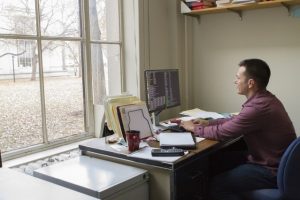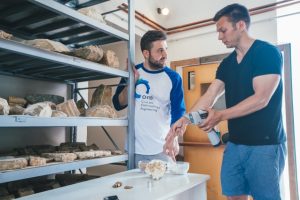
Concrete is all around us, from buildings and sidewalks to bridges and roads, but graduate student Steven Palkovic sees it as more than just the most-used human-made material in the world; he sees it as an environmental problem. The production of concrete contributes up to 10 percent of the world’s carbon dioxide, and Palkovic hopes to reduce this environmental impact through his research of cement paste, the matrix of concrete materials that binds everything together.
Palkovic studies cement paste at multiple scales, spanning from atoms to millimeters in length. His computational framework, developed with Professor Oral Buyukozturk of the Department of Civil and Environmental Engineering (CEE), promises to have a wide impact on the influence of changes in structure and properties caused by additives at multiple length scales for concrete mixes. These additives can be used as replacement for Portland cement, the largest contributor to carbon dioxide emissions during concrete productions.
Palkovic is an active member of CEE, serving as a teaching assistant for a summer fieldwork program on Materials in Art, Archeology and Architecture (ONE-MA³) and playing intramural sports. A lifelong Red Sox fan, Palkovic moved from New York to Boston for his undergraduate degree in civil engineering at Northeastern University, which he received in 2012. He earned his master’s degree in CEE in 2014 before pursuing a PhD in the department. Palkovic recently spoke with CEE about his work.
Q: What are the real world implications of your research?
A: The biggest implication of my research is being able to reduce our dependence on Portland cement, a generic name for limestone and other raw materials that are processed and mixed with water to form the glue for cementitious materials, in concrete and cement paste design. Due to the huge quantities used in construction, the production of Portland cement contributes 5 to 10 percent of the world’s greenhouse gases, so it is important to address that environmental impact.
I am looking at how we can investigate cement paste with different modeling techniques, and transfer this information seamlessly between length scales. When we understand what features promote improved performance, we can design new mixes that replace Portland cement with other suitable materials. Specifically, my group is studying volcanic ash, an additive that’s already reactive and readily available. This way, you don’t have to make as much Portland cement and use it in your mix, and that’s much more sustainable.
Since I work on such small scales, simulations can be used as a computational microscope for understanding what’s going on. My thesis is developing a computational framework that’s basically modeling cementitious materials from atoms up to the size of a dozen hairs. When we change the material by incorporating additives, my models need to be flexible enough to account for associated changes in chemistry, interactions and morphology throughout the material.
Ultimately, I hope that my research will contribute to a better understanding of how to use, how to activate, and how to proportion different additives within the material to get properties that you want. This would enable performance based material design.
Right now the industry progresses through trial-and-error, which is inefficient. You put in different amounts of an additive within the mix, add water, wait 28 days for it to harden, measure it with laboratory tests, and you evaluate “How good is this?” to determine the properties of the resulting concrete. The big goal of the industry has been to determine how we could design concrete to achieve specific properties and quality ahead of time based on the available raw materials, and this framework will contribute to filling that void.

Steven Palkovic works under the supervision of Professor Oral Buyukozturk of the Pierce Lab in MIT’s Building 1. Photo: Allison Dougherty/Department of Civil and Environmental Engineering
Q: What opportunities have you had to delve deeper into your research?
A: MIT has given me a lot of opportunities to travel. This past summer, I travelled to Italy as a teaching assistant for ONE-MA³, a new CEE summer fieldwork program led by CEE Assistant Professor Admir Masic.
We travelled to Priverno and Pompeii and looked at the materials the Romans used for their structures. Similar to my research, the Romans also used volcanic ash as an additive in their concrete. This experience really affirmed that, like the Romans, we can use locally available materials to achieve building materials that can survive for millennia.
The trip also allowed me to obtain a perspective on the importance of materials in cultural heritage. We met world experts in preservation and restoration who taught us how local materials and different processing techniques could be used to create mortar for buildings or pigments in a fresco. The class emphasized how modern technology can be applied to study these ancient materials to look for secrets that explain their incredible durability.

As a teaching assistant for the summer fieldwork class 1.S993 (Special Undergraduate Subject in CEE), Steven Palkovic (right) explained to a student how to use a handheld X-ray fluorescence spectrometer to learn about material properties. Photo: Lillie Paquette/School of Engineering
Q: What’s the next step for you?
A: I became really interested in research as an undergraduate at Northeastern, and that led me to MIT, where I have had amazing research opportunities. CEE has changed my focus from a structural engineer that studied buildings to a material scientist investigating the world’s most widely used civil engineering material. Looking towards the future, I want to apply my research to private industry.
Understanding how materials behave at different scales has given me a better appreciation of mechanics and design. I’d like to apply these skills in the industry for developing novel ways to characterizing material properties at different length scales.